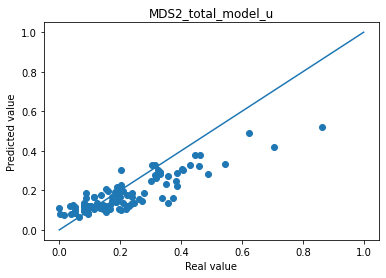Advanced Leaspy Utilisation#
This is already the last practical session of the day ! Be carefull you only have an hour and a half.
Objectives :#
Understand data format that is needed to use Leaspy,
Learn to use parameters
Explore models selection
The set-up#
As before, if you have followed the installation details carefully, you should
be running this notebook in the
leaspy_tutorialvirtual environmenthaving all the needed packages already installed
💬 Question 1 💬 Run the following command lines.
import os, sys
import numpy as np
import pandas as pd
import matplotlib.pyplot as plt
import seaborn as sns
import copy
from scipy import stats
%matplotlib inline
from leaspy import Leaspy, IndividualParameters, AlgorithmSettings, Data
Part I: The prediction#
One of the main issue of Parkinson disease specialized doctor is that they do not know how fast will the disease evolved and then are unable to set the right spacing between two visits wih their patients. In addition, they would like to give advises to their patients for them to anticipate administrative obligations by the time they are still able to do them. The most important score to monitore is MDS3_off_total, but it is always nice to have a some others.
Leaspy could be a great tool to help solving those issues. The following part contains the main structure to train and test a leaspy model.
I.1. Prepare your data#
ℹ️ Information ℹ️ Two datasets, containing 200 patients, are available :
learn_leaspy2 : contains historic data of patients visits,
pred_leaspy2 : contains the next visit for each patient, that it would be nice to predict.
💬 Question 2 💬 Run the following command lines to load the data.
data_path = os.path.join(os.getcwd(),'..','data/TP3_advanced_leaspy/')
df = pd.read_csv(data_path + "learn_leaspy2.csv")
df.set_index(['ID', 'TIME'], inplace=True)
df.head()
| MDS1_total | MDS2_total | MDS3_off_total | SCOPA_total | MOCA_total | PUTAMEN_R | PUTAMEN_L | CAUDATE_R | CAUDATE_L | AGD_total | ||
|---|---|---|---|---|---|---|---|---|---|---|---|
| ID | TIME | ||||||||||
| GS-001 | 62.289333 | NaN | 3.556297 | -9.000000 | 0.000000 | 26.784926 | 0.168703 | 0.140237 | 0.069723 | 0.041532 | 0.078704 |
| 62.789333 | 4.644412 | 6.570468 | 15.658805 | 5.721043 | 25.303684 | 0.146405 | 0.172067 | 0.034234 | 0.089805 | 0.374873 | |
| 63.289333 | 1.955755 | 2.621946 | 29.142870 | 0.000000 | 30.000000 | 0.163331 | 0.188258 | 0.069586 | 0.060110 | 0.194420 | |
| 64.289330 | NaN | 0.000000 | 44.319816 | 44.560006 | 29.851244 | 0.185705 | 0.177019 | 0.053399 | 0.076220 | 0.237782 | |
| 64.789330 | 4.169568 | 4.752366 | 29.652244 | 0.000000 | 28.533121 | 0.194951 | 0.171595 | 0.048021 | 0.083921 | 0.159916 |
df_vis = pd.read_csv(data_path + "pred_leaspy2.csv")
df_vis.set_index(['ID'], inplace=True)
df_vis.head()
| TIME | MDS1_total | MDS2_total | MDS3_off_total | SCOPA_total | MOCA_total | PUTAMEN_R | PUTAMEN_L | CAUDATE_R | CAUDATE_L | AGD_total | |
|---|---|---|---|---|---|---|---|---|---|---|---|
| ID | |||||||||||
| GS-001 | 69.089333 | 4.960370 | 5.635592 | 45.674665 | 13.727753 | 27.915718 | 0.209688 | 0.229443 | 0.105179 | 0.137542 | 0.319582 |
| GS-002 | 73.647736 | 14.674264 | 9.983259 | 48.461299 | 1.777607 | 19.778270 | 0.268539 | 0.211596 | 0.196772 | 0.193251 | 0.404642 |
| GS-003 | 62.491299 | NaN | 9.429927 | -9.000000 | 27.019072 | 24.602786 | 0.182493 | 0.151622 | 0.056601 | 0.096034 | 0.347589 |
| GS-004 | 67.666000 | 7.170177 | 3.978171 | 7.608285 | 0.000000 | 27.879789 | 0.223414 | 0.185168 | 0.186051 | 0.182661 | 0.312880 |
| GS-005 | 74.125290 | NaN | 3.628875 | -9.000000 | 3.493040 | 28.498334 | 0.197911 | 0.189411 | 0.114025 | 0.122356 | 0.336951 |
ℹ️ Information ℹ️ You have the following informations about scores :
MDS1_total : increasing score from 0 to 52,
MDS2_total : increasing score from 0 to 52,
MDS3_off_total : increasing score from 0 to 132,
SCOPA_total : increasing score from 0 to 72,
MOCA_total : decreasing score from 30 to 0,
AGD_total : unknown positive score (will need to be explored),
Others : the rest are imaging increasing score and then have no border, except that they are suppose to be positive.
💬 Question 3 💬 Plot histogram to check that the data are as expected.
# To complete
# –––––––––––––––– #
# –––– Answer –––– #
# –––––––––––––––– #
df.hist(figsize = (10,10))
plt.show()
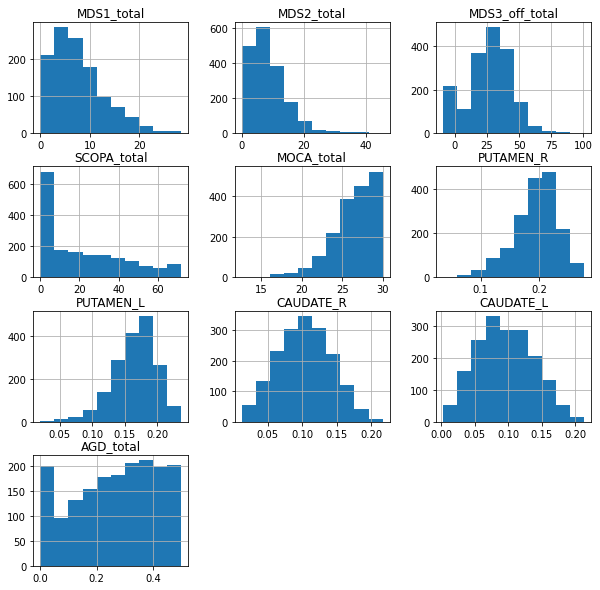
💬 Question 4 💬 Check that the variables respect the constraints. How can you interpret those unexpected datas ?
Your answer: …
💬 Question 5 💬 Apply the right pre-processing to those unexpected data. Do not forget to apply it on ALL the data.
# To complete
# –––––––––––––––– #
# –––– Answer –––– #
# –––––––––––––––– #
df = df.replace(-9,np.nan)
df_vis = df_vis.replace(-9,np.nan)
ℹ️ Information ℹ️ Leaspy model is able to handle NaN, but it is always important to quantify them.
💬 Question 6 💬 Return the number of NaN by feature.
# To complete
# –––––––––––––––– #
# –––– Answer –––– #
# –––––––––––––––– #
df.isna().sum()
MDS1_total 596
MDS2_total 0
MDS3_off_total 196
SCOPA_total 0
MOCA_total 0
PUTAMEN_R 0
PUTAMEN_L 0
CAUDATE_R 0
CAUDATE_L 0
AGD_total 0
dtype: int64
ℹ️ Information ℹ️ Leaspy model only takes normalised increasing with time data.
💬 Question 7 💬 Using the functions below, explore AGD_total to try to understand its progression and compare it to other features.
def plot_individuals(df, feature, sublist=None):
plt.figure(figsize=(12, 6))
if sublist is None:
sublist = df.index.unique('ID')
colors = sns.color_palette(palette='icefire', n_colors=len(sublist), desat=None, as_cmap=False)
for c, idx in zip(colors, sublist):
indiv_df = df.loc[idx]
ages = indiv_df.index.get_level_values(0)
real_values = indiv_df[feature].values
plt.plot(ages, real_values, c=c)
plt.xlabel("Age in years")
plt.ylabel(feature)
plt.title("Evolution for each patient of " + feature)
def individual_linear_regression_against_time(df, feature):
# individual linear regressions on each feature, to study individual progression (with linear regression against age)
lin_reg_on_frame_time_y = lambda t: pd.Series(dict(zip(['slope','intercept','correl_coef','pval','stderr','intercept_stderr'],
stats.linregress(t.values))))
# select individuals with at least 3 visits
s = df[feature].dropna()
nb_visits_with_data = s.groupby('ID').size()
s = s.loc[nb_visits_with_data[nb_visits_with_data >= 3].index]
return s.reset_index('TIME').groupby('ID').apply(lin_reg_on_frame_time_y)
# To complete
# –––––––––––––––– #
# –––– Answer –––– #
# –––––––––––––––– #
plot_individuals(df, "AGD_total", sublist = df.index.unique('ID')[:8])
plt.grid()
plt.show()
for ft_name, s in df.items():
ilr_ft = individual_linear_regression_against_time(df, ft_name)
ax = ilr_ft[['slope','correl_coef', 'pval']].hist(figsize=(14,5), layout=(1,3))
plt.gcf().suptitle(ft_name+'\n', fontweight='bold', fontsize=20)
plt.show()
print(f"{ft_name}: linear correlation coefficient with time = "
f"{ilr_ft['correl_coef'].mean():.2f} ± {ilr_ft['correl_coef'].std():.2f}")
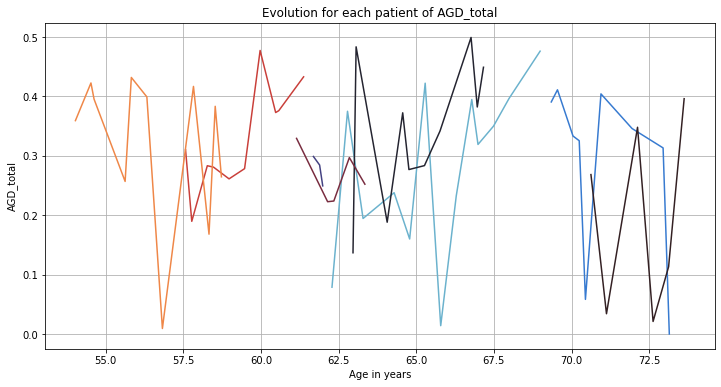
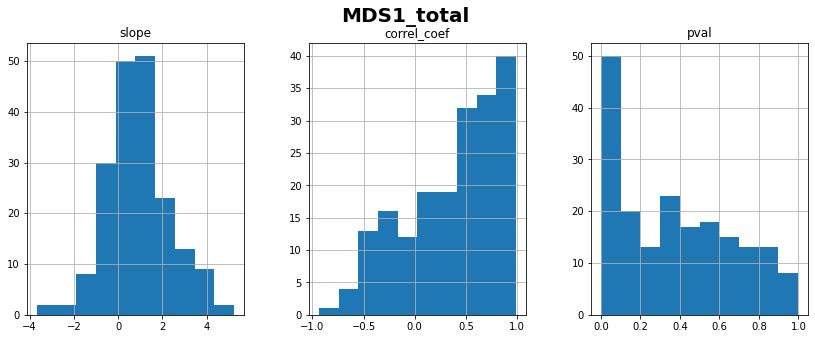
MDS1_total: linear correlation coefficient with time = 0.36 ± 0.45
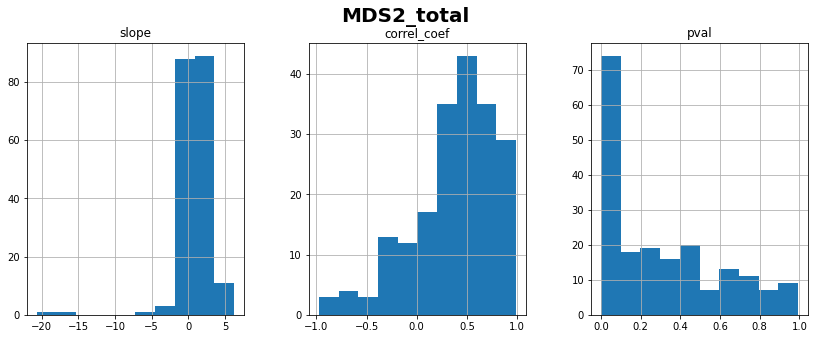
MDS2_total: linear correlation coefficient with time = 0.37 ± 0.42
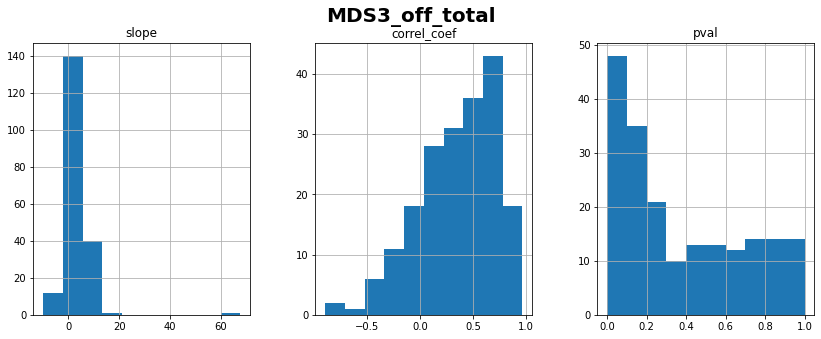
MDS3_off_total: linear correlation coefficient with time = 0.35 ± 0.37
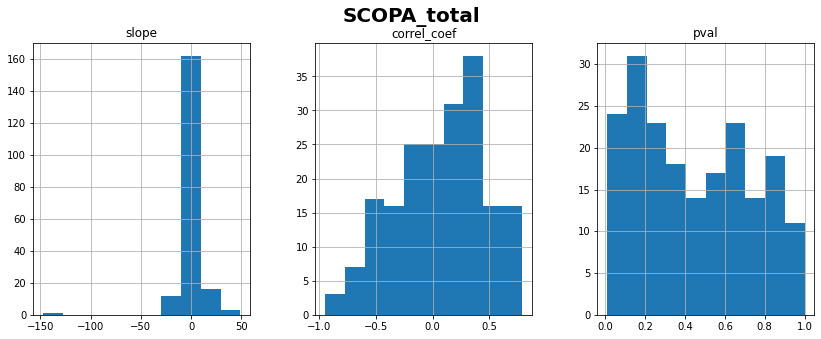
SCOPA_total: linear correlation coefficient with time = 0.08 ± 0.40

MOCA_total: linear correlation coefficient with time = -0.20 ± 0.39
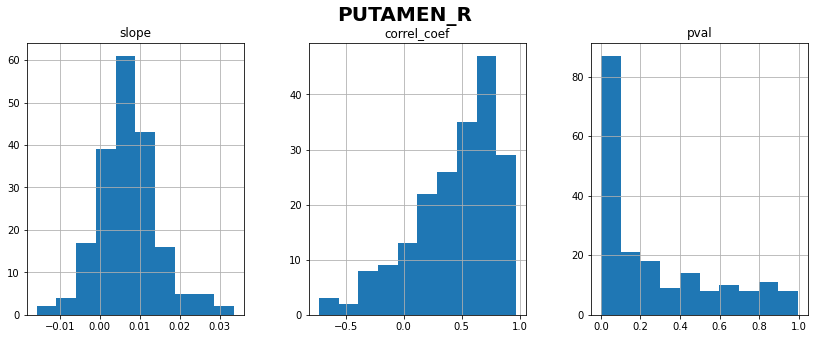
PUTAMEN_R: linear correlation coefficient with time = 0.44 ± 0.37
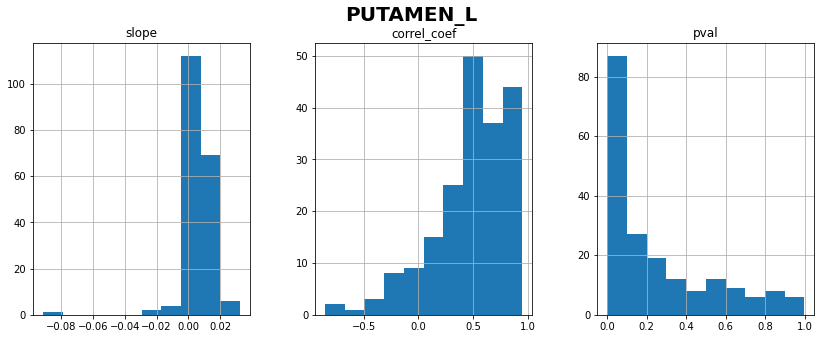
PUTAMEN_L: linear correlation coefficient with time = 0.48 ± 0.35
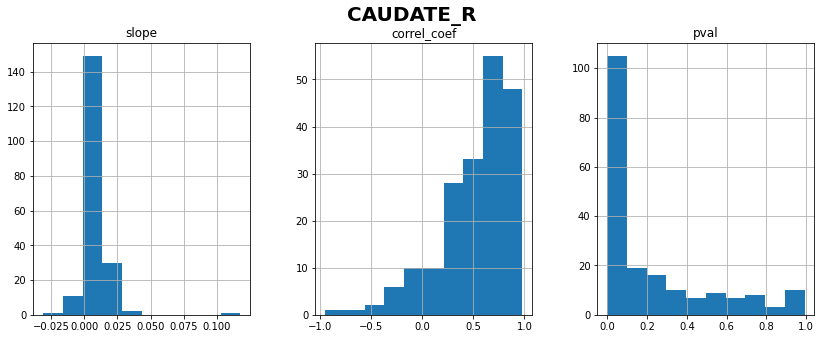
CAUDATE_R: linear correlation coefficient with time = 0.53 ± 0.35
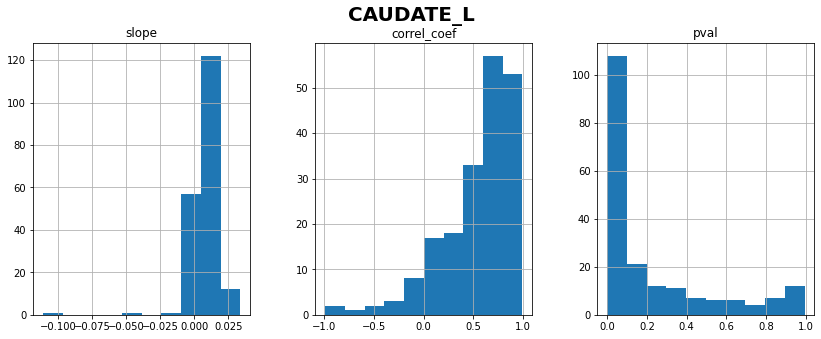
CAUDATE_L: linear correlation coefficient with time = 0.54 ± 0.36
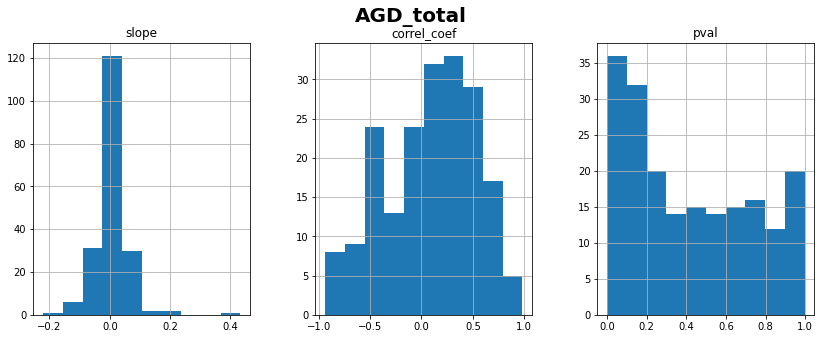
AGD_total: linear correlation coefficient with time = 0.09 ± 0.44
💬 Question 8 💬 What do you conclude about AGD_total progression? Should we consider it for longitudinal modeling?
Your answer: …
💬 Question 9 💬 Now that you know the progression of all the features, can you normalize them all now? If not what is the issue and which features are concerned?
Your answer: …
💬 Question 10 💬 Run the code below to split the data into a training and testing set.
##CREATE TRAINING AND TESTING SETS
patient_stop = 'GS-100'
patient_start = 'GS-101'
df_train = df.loc[:patient_stop].copy()
df_test = df.loc[patient_start:].copy()
df_to_pred = df_vis.loc[patient_start:].copy()
💬 Question 11 💬 Normalize the data using the function below and making sure that you have increasing data at the end.
def normalize(df, feat, max_, min_, increase = True ):
df_study = df[feat].copy()
df_study = (df_study - min_) / (max_ - min_)
if not increase :
df_study = 1 - df_study
return df_study
# To complete
# –––––––––––––––– #
# –––– Answer –––– #
# –––––––––––––––– #
# bounded scores
scores = {
"MDS1_total": (52, 0, True), # max, min, increase?
"MDS2_total": (52, 0, True),
"MDS3_off_total": (132, 0, True),
"SCOPA_total": (72, 0, True),
"MOCA_total": (30, 0, False),
#"AGD_total": #No need we will not use it...
}
for score_name, normalize_args in scores.items():
df_train.loc[:, score_name] = normalize(df_train, score_name, *normalize_args )
df_test.loc[:, score_name] = normalize(df_test, score_name, *normalize_args )
df_to_pred.loc[:, score_name] = normalize(df_to_pred, score_name, *normalize_args )
# imagery (all features are increasing)
for var_name in ['PUTAMEN_R', 'PUTAMEN_L', 'CAUDATE_R', 'CAUDATE_L']:
df_test.loc[:, var_name] = normalize(df_test, var_name, df_train[var_name].max(),
df_train[var_name].min(), increase = True )
I.2. Train your model#
ℹ️ Information ℹ️ Be carefull you have only an hour and half and running a leaspy model on ten features can take a lot of time… We advise you to start by univariate model …
💬 Question 12 💬 Complete the code below to select the columns you want to use to train your leaspy model.
# To complete
col = #####################################
data_train = Data.from_dataframe(df_train[col])
data_test = Data.from_dataframe(df_test[col])
df_to_pred = df_to_pred
# –––––––––––––––– #
# –––– Answer –––– #
# –––––––––––––––– #
col = ["MDS3_off_total", "MDS2_total"]
data_train = Data.from_dataframe(df_train[col])
data_test = Data.from_dataframe(df_test[col])
df_to_pred = df_to_pred
💬 Question 13 💬 Complete the code below to set the parameters you want for your model.
# To complete
leaspy_model = ###############
nb_source = ###############
algo_settings = #################
algo_settings.set_logs(path='logs',
console_print_periodicity=None, # If = N, it display logs in the console/terminal every N iterations
overwrite_logs_folder=True # Default behaviour raise an error if the folder already exists.
)
##FIT
leaspy = Leaspy(leaspy_model)
leaspy.model.load_hyperparameters({'source_dimension': nb_source})
leaspy.fit(data_train, algorithm_settings=algo_settings)
# –––––––––––––––– #
# –––– Answer –––– #
# –––––––––––––––– #
leaspy_model = "logistic" #'univariate'
nb_source = 1
algo_settings = AlgorithmSettings('mcmc_saem',
n_iter=3000, # n_iter defines the number of iterations
progress_bar=True) # To display a nice progression bar during calibration
algo_settings.set_logs(path='logs',
console_print_periodicity=None, # If = N, it display logs in the console/terminal every N iterations
overwrite_logs_folder=True # Default behaviour raise an error if the folder already exists.
)
##FIT
leaspy = Leaspy(leaspy_model)
leaspy.model.load_hyperparameters({'source_dimension': nb_source})
leaspy.fit(data_train, algorithm_settings=algo_settings)
#leaspy = Leaspy.load('./outputs/model_parameters.json')
...overwrite logs folder...
|##################################################| 3000/3000 iterations
The standard deviation of the noise at the end of the calibration is:
0.0582
Calibration took: 2min 48s
💬 Question 14 💬 Evaluate that your model learned well and then save it.
# To complete
# –––––––––––––––– #
# –––– Answer –––– #
# –––––––––––––––– #
# Check the logs, the noise std, coherence of model parameters, ...
leaspy.save('./outputs/model_parameters.json', indent=2)
print(leaspy.model.parameters)
from IPython.display import IFrame
IFrame('./logs/plots/convergence_1.pdf', width=990, height=670)
{'g': tensor([0.9264, 1.3880]), 'v0': tensor([-4.4238, -4.1641]), 'betas': tensor([[-0.0449]]), 'tau_mean': tensor(71.3112), 'tau_std': tensor(10.0713), 'xi_mean': tensor(0.), 'xi_std': tensor(0.6131), 'sources_mean': tensor(0.), 'sources_std': tensor(1.), 'noise_std': tensor(0.0582)}
I.3. Test your model#
💬 Question 15 💬 Complete the code below to make the predictions.
# To complete
##SET PARAMETERS
settings_personalization = #################
##PREDICTIONS
ip = #################
reconstruction = #################
d2 = {k: v[0] for k, v in reconstruction.items()}
df_pred = pd.DataFrame.from_dict(d2, orient='index', columns = [s+"_model1" for s in col])
# –––––––––––––––– #
# –––– Answer –––– #
# –––––––––––––––– #
##SET PARAMETERS
settings_personalization = AlgorithmSettings('scipy_minimize', progress_bar=True, use_jacobian=True)
##PREDICTIONS
ip = leaspy.personalize(data_test, settings_personalization)
reconstruction = leaspy.estimate(dict(zip(df_to_pred.index,df_to_pred['TIME'])), ip)
d2 = {k: v[0] for k, v in reconstruction.items()}
df_pred = pd.DataFrame.from_dict(d2, orient='index', columns = [s+"_model1" for s in col])
|##################################################| 100/100 subjects
The standard deviation of the noise at the end of the personalization is:
0.0567
Personalization scipy_minimize took: 2s
💬 Question 16 💬 Display results of your prediction against real values and the mean absolute error.
# To complete
# –––––––––––––––– #
# –––– Answer –––– #
# –––––––––––––––– #
for s in col :
print("Mean absolute error "+s+" : " + str(np.abs(df_to_pred[s]-df_pred[s+'_model1']).mean()))
plt.scatter(df_to_pred[s], df_pred[s+'_model1'])
plt.plot([0,1],[0,1])
plt.title(s)
plt.xlabel("Real value")
plt.ylabel("Predicted value")
plt.show()
Mean absolute error MDS3_off_total : 0.059690863332327676
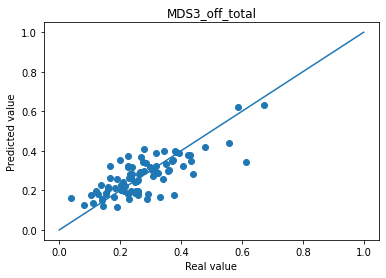
Mean absolute error MDS2_total : 0.05356992930173874

ℹ️ Information ℹ️ Note that an average good error is about 5% of absolute error for MDS3_off_total.
Part II: The cofactor evaluation#
Besides prediction, the individual parameters are interesting in the sense that they provide meaningful and interesting insights about the disease progression. For that reasons, these individual parameters can be correlated to other cofactors. Let’s consider that you have a covariate Cofactor 1 that encodes a genetic status: 1 if a specific mutation is present, 0 otherwise. Now, let’s see if this mutation has an effect on the disease progression.
💬 Question 17 💬 Complete the code below to see the repartition of carriers and non carriers.
# To complete
import seaborn as sns
# —— Convert individual parameters to dataframe
df_ip = ###############
# —— Join the cofactors to individual parameters
cofactor = pd.read_csv(data_path + "cof_leaspy2.csv", index_col=['ID'])
df_ip = df_ip.join(cofactor.replace({'MUTATION':{0: 'Non-carrier', 1: 'Carrier'}}))
_, ax = plt.subplots(1, 2, figsize=(14, 6))
# —— Plot the time shifts in carriers and non-carriers
ax[0].set_title('Time shift histogram')
sns.histplot(data=df_ip, x=..., hue=..., bins=15, ax=ax[0], stat='count', common_norm=False, kde=True)
# —— Plot the acceleration factor in carriers and non-carriers
ax[1].set_title('Log-Acceleration factor histogram')
sns.histplot(data=df_ip, x=..., hue=..., bins=15, ax=ax[0], stat='count', common_norm=False, kde=True)
plt.show()
# __ Joint density (tau, xi) __
g = sns.jointplot(data=..., x=..., y=..., hue=..., height=6)
g.plot_joint(sns.kdeplot, zorder=0, levels=8, bw_adjust=1.5)
g.ax_joint.grid();
# __ Nb of mutated patients ___
df_ip['MUTATION'].value_counts(dropna=False)
# –––––––––––––––– #
# –––– Answer –––– #
# –––––––––––––––– #
import seaborn as sns
# —— Convert individual parameters to dataframe
df_ip = ip.to_dataframe()
# —— Join the cofactors to individual parameters
cofactor = pd.read_csv(data_path + "cof_leaspy2.csv", index_col=['ID'])
df_ip = df_ip.join(cofactor.replace({'MUTATION':{0: 'Non-carrier', 1: 'Carrier'}}))
_, ax = plt.subplots(1, 2, figsize=(14, 6))
# —— Plot the time shifts in carriers and non-carriers
ax[0].set_title('Time shift histogram')
sns.histplot(data=df_ip, x='tau', hue='MUTATION', bins=15, ax=ax[0], stat='count', common_norm=False, kde=True)
# —— Plot the acceleration factor in carriers and non-carriers
ax[1].set_title('Log-Acceleration factor histogram')
sns.histplot(data=df_ip, x='xi', hue='MUTATION', bins=15, ax=ax[1], stat='count', common_norm=False, kde=True)
plt.show()
# __ Joint density (tau, xi) __
g = sns.jointplot(data=df_ip, x="tau", y="xi", hue="MUTATION", height=6)
g.plot_joint(sns.kdeplot, zorder=0, levels=8, bw_adjust=1.5)
g.ax_joint.grid();
# __ Nb of mutated patients ___
df_ip['MUTATION'].value_counts(dropna=False)

Non-carrier 71
Carrier 29
Name: MUTATION, dtype: int64

💬 Question 18 💬 Make a statistic tests using stats.ttest_ind and stats.mannwhitneyu.
# To complete
# –––––––––––––––– #
# –––– Answer –––– #
# –––––––––––––––– #
carriers = df_ip[df_ip['MUTATION'] == 'Carrier']
non_carriers = df_ip[df_ip['MUTATION'] == 'Non-carrier']
# —— Student t-test (under the asumption of a gaussian distribution only)
print(stats.ttest_ind(carriers['tau'], non_carriers['tau']))
print(stats.ttest_ind(carriers['xi'], non_carriers['xi']))
# —— Mann-withney t-test
print(stats.mannwhitneyu(carriers['tau'], non_carriers['tau']))
print(stats.mannwhitneyu(carriers['xi'], non_carriers['xi']))
Ttest_indResult(statistic=6.116870627752805, pvalue=1.958990326701787e-08)
Ttest_indResult(statistic=-2.9131535065482375, pvalue=0.004431884326689646)
MannwhitneyuResult(statistic=301.0, pvalue=1.6002231482727975e-08)
MannwhitneyuResult(statistic=662.0, pvalue=0.0026530380825654097)
Part III: Univariate vs Multivariate#
Now that you have a multivariate model that works, let’s compare the multivariate and univariate model. For that you will compare a multivariate model with MDS3 and MDS2 with two univariate model MDS2 and MDS3 separatly.
💬 Question 19 💬 Fit 3 models, one multivariate and two univariate with MDS2 and MDS3.
# To complete
leaspy_model_u = ###########################
leaspy_model = ###########################
algo_settings = ###########################
#With MDS2 and MDS3
data_train23 = ###########################
data_test23 = ###########################
leaspy23 = #########
###########################
#With MDS3
data_train3 = ##################
data_test3 = ##################
leaspy3 = ##################
##################
#With MDS2
##########################
# –––––––––––––––– #
# –––– Answer –––– #
# –––––––––––––––– #
leaspy_model_u = 'univariate_logistic'
leaspy_model = "logistic" #'univariate'
algo_settings = AlgorithmSettings('mcmc_saem',
n_iter=3000, # n_iter defines the number of iterations
progress_bar=True) # To display a nice progression bar during calibration
#algo_settings.set_logs(path=...)
#With MDS2 and MDS3
data_train23 = Data.from_dataframe(df_train[["MDS3_off_total", "MDS2_total"]])
data_test23 = Data.from_dataframe(df_test[["MDS3_off_total", "MDS2_total"]])
leaspy23 = Leaspy(leaspy_model)
leaspy23.fit(data_train23, algorithm_settings=algo_settings)
leaspy23.save('./outputs/model_parameters_23.json', indent=2)
#With MDS3
data_train3 = Data.from_dataframe(df_train[["MDS3_off_total"]])
data_test3 = Data.from_dataframe(df_test[["MDS3_off_total"]])
leaspy3 = Leaspy(leaspy_model_u)
leaspy3.fit(data_train3, algorithm_settings=algo_settings)
leaspy3.save('./outputs/model_parameters_3.json', indent=2)
#With MDS2
data_train2 = Data.from_dataframe(df_train[["MDS2_total"]])
data_test2 = Data.from_dataframe(df_test[["MDS2_total"]])
leaspy2 = Leaspy(leaspy_model_u)
leaspy2.fit(data_train3, algorithm_settings=algo_settings)
leaspy2.save('./outputs/model_parameters_2.json', indent=2)
|##################################################| 3000/3000 iterations
The standard deviation of the noise at the end of the calibration is:
0.0583
Calibration took: 53s
|##################################################| 3000/3000 iterations
The standard deviation of the noise at the end of the calibration is:
0.0661
Calibration took: 12s
|##################################################| 3000/3000 iterations
The standard deviation of the noise at the end of the calibration is:
0.0669
Calibration took: 9s
💬 Question 20 💬 Make the predictions for each model.
# To complete
##SET PARAMETERS
settings_personalization = #############################
##PREDICTIONS MDS3
ip23 = #############################
reconstruction23 = leaspy23.estimate(dict(zip(df_to_pred.index,df_to_pred['TIME'])), ip23)
d223 = {k: v[0] for k, v in reconstruction23.items()}
df_pred23 = pd.DataFrame.from_dict(d223, orient='index', columns = ["MDS3_off_total_model_m", "MDS2_total_model_m"])
##PREDICTIONS MDS3
ip3 = #############################
reconstruction3 = leaspy3.estimate(dict(zip(df_to_pred.index,df_to_pred['TIME'])), ip3)
d23 = {k: v[0] for k, v in reconstruction3.items()}
df_pred3 = pd.DataFrame.from_dict(d23, orient='index', columns = ["MDS3_off_total_model_u"])
##PREDICTIONS MDS3
#############################
#CONCATE PREDICTIONS
df_pred_mu = pd.concat([df_pred23, df_pred3, df_pred2], axis = 1)
# –––––––––––––––– #
# –––– Answer –––– #
# –––––––––––––––– #
##SET PARAMETERS
settings_personalization = AlgorithmSettings('scipy_minimize', progress_bar=True, use_jacobian=True)
##PREDICTIONS MDS3
ip23 = leaspy23.personalize(data_test23, settings_personalization)
reconstruction23 = leaspy23.estimate(dict(zip(df_to_pred.index,df_to_pred['TIME'])), ip23)
d223 = {k: v[0] for k, v in reconstruction23.items()}
df_pred23 = pd.DataFrame.from_dict(d223, orient='index', columns = ["MDS3_off_total_model_m", "MDS2_total_model_m"])
##PREDICTIONS MDS3
ip3 = leaspy3.personalize(data_test3, settings_personalization)
reconstruction3 = leaspy3.estimate(dict(zip(df_to_pred.index,df_to_pred['TIME'])), ip3)
d23 = {k: v[0] for k, v in reconstruction3.items()}
df_pred3 = pd.DataFrame.from_dict(d23, orient='index', columns = ["MDS3_off_total_model_u"])
##PREDICTIONS MDS3
ip2 = leaspy2.personalize(data_test2, settings_personalization)
reconstruction2 = leaspy2.estimate(dict(zip(df_to_pred.index,df_to_pred['TIME'])), ip2)
d22 = {k: v[0] for k, v in reconstruction2.items()}
df_pred2 = pd.DataFrame.from_dict(d22, orient='index', columns = ["MDS2_total_model_u"])
#CONCATE PREDICTIONS
df_pred_mu = pd.concat([df_pred23, df_pred3, df_pred2], axis = 1)
|##################################################| 100/100 subjects
The standard deviation of the noise at the end of the personalization is:
0.0569
Personalization scipy_minimize took: 3s
|##################################################| 100/100 subjects
The standard deviation of the noise at the end of the personalization is:
0.0687
Personalization scipy_minimize took: 1s
|##################################################| 100/100 subjects
The standard deviation of the noise at the end of the personalization is:
0.0707
Personalization scipy_minimize took: 1s
💬 Question 21 💬 Display results of predictions against real values and the mean absolute error.
# To complete
# –––––––––––––––– #
# –––– Answer –––– #
# –––––––––––––––– #
col_plot = ['MDS3_off_total_model_m', 'MDS3_off_total_model_u', 'MDS2_total_model_m', 'MDS2_total_model_u']
col_real = ['MDS3_off_total', 'MDS3_off_total','MDS2_total', 'MDS2_total']
for i in range(len(col_plot)) :
print("Mean absolute error "+col_plot[i]+" : " + str(np.abs(df_to_pred[col_real[i]]-df_pred_mu[col_plot[i]]).mean()))
plt.scatter(df_to_pred[col_real[i]], df_pred_mu[col_plot[i]])
plt.plot([0,1],[0,1])
plt.title(col_plot[i])
plt.xlabel("Real value")
plt.ylabel("Predicted value")
plt.show()
Mean absolute error MDS3_off_total_model_m : 0.05958525082644294
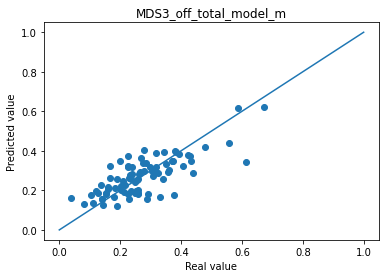
Mean absolute error MDS3_off_total_model_u : 0.06501929260352078
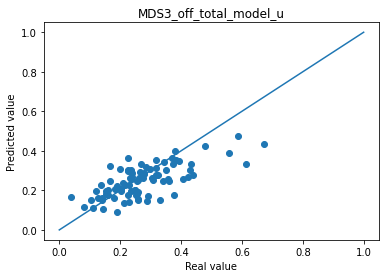
Mean absolute error MDS2_total_model_m : 0.05325222294777632

Mean absolute error MDS2_total_model_u : 0.0676489770412445
